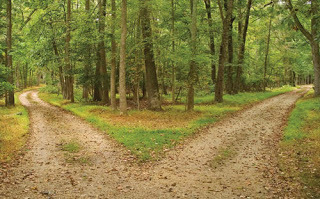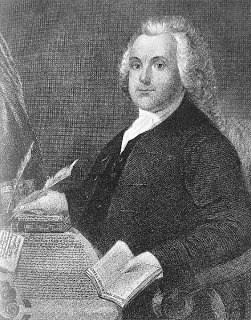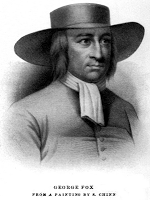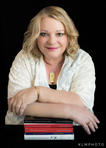Where Paths Diverge: The Great Quaker Debate
I'm pleased to present a guest post by a friend I met through the Mary Barrett Dyer Facebook page. Thank you so much, Ken, for adding to our understanding of the life-and-death issues that surrounded Massachusetts Bay and Rhode Island Colonies in the 17th century.
© Ken Horn (use in this site by author'spermission)
 Picture twopeople traveling down the same road, in seeming accord. Both meet a wayfarer …and respond in directly opposite ways. One is captivated, the other appalled.One sees an open door, the other an obstacle. To one it's an opportunity, tothe other a stumbling block. For Mary Dyer and Roger Williams (1604?-1683) thatwayfarer was George Fox, the founder of Quakerism. And the paths of Dyer andWilliams diverged—radically.
Picture twopeople traveling down the same road, in seeming accord. Both meet a wayfarer …and respond in directly opposite ways. One is captivated, the other appalled.One sees an open door, the other an obstacle. To one it's an opportunity, tothe other a stumbling block. For Mary Dyer and Roger Williams (1604?-1683) thatwayfarer was George Fox, the founder of Quakerism. And the paths of Dyer andWilliams diverged—radically.
Dyer wouldbecome a Quaker and eventually give her life for that cause; Williams became abitter enemy of the Quakers, though his principled adherence to the separationof church and state and freedom of religion kept him from ever wielding theforce of law against them in Rhode Island. Instead, the pen and the tongue were hisweapons.
After AnneHutchinson was expelled from Massachusetts Bay Colony in 1638 on grounds ofheresy, she and her family, and scores of her followers, sought the refuge Roger Williams had created in hiscolony.
 Roger Williams and the Rhode Island CharterWilliams hadfled the persecution of Archbishop Laud in England,arriving in Bostonin 1631. He went to Salem and became a teacher of the church, but waseventually banished (in the dead of winter) because of his radical views onreligious liberty, the separation of church and state, and fair compensationand godly interaction with the Native Americans.
Roger Williams and the Rhode Island CharterWilliams hadfled the persecution of Archbishop Laud in England,arriving in Bostonin 1631. He went to Salem and became a teacher of the church, but waseventually banished (in the dead of winter) because of his radical views onreligious liberty, the separation of church and state, and fair compensationand godly interaction with the Native Americans.
He took thosebeliefs with him and put them to work when he founded Providence Plantation,which eventually was united with Portsmouth, Newport, and Warwick to form Rhode Island Colony. After purchasing the landfor a fair amount from the Narragansett Indians in 1636, Williams' uniquesociety was built on the foundation of freedom of religion.
When thePuritans risked all to cross the ocean, they were not seeking freedom of religionas we understand it today. Toleration was not part of their goal. Instead theysought freedom for their religion—strict Calvinism—and toleration of otherforms of Christianity was not included. As a result, dissenters from the statereligions (Anglican, Catholic, Jew) were drawn to Williams' haven for refuge.
In 1639 Baptiststook refuge in the colony and influenced Williams to accept their view of waterbaptism—immersion for believers, no infant baptisms—doctrines contrary toPuritan teaching and practice. He was rebaptized by Ezekiel Holliman, who hadbeen a member of the Salem church Williams hadministered in, and helped found the first Baptist church in America.
But therelationship did not last. Williams left it in short order to become a "Seeker"and wait for the restoration of the true church. He came to believe that thetrue church no longer existed, its succession being broken when Constantine instituted the first state church in Rome in the fourthcentury.
Following herhusband's death, Anne took her family to Dutch territories. She and five of herchildren were killed by Indians in 1643.
The Dyers had also been banished with the Hutchinsonsto Rhode Island in 1638.In 1651, William Dyer, now Attorney General of Rhode Island, accompanied Roger Williams and John Clarke to England, where they obtained a confirmation of their charter and revoked divisive land claims of the governor. Mary Dyer sailed for England in early 1652, remained five years, and became a follower of Fox.
In Rhode Island, the strongfoundation of freedom of religious expression survived the onslaught ofinternal problems brought about by the hearty individualism that very freedomfostered. Rhode Islandbecame a haven to the Quakers but Williams came to distrust, even dislike,them.
Fox's teachingincluded the precept of the "Inner Light," a mystic tenet which was similar toAnne Hutchinson's "Antinomianism." To Dyer, the Quaker cause was worth dyingfor. To Williams, it deserved the worst of his open scorn.
Mary's fateafter becoming a follower of Fox is well documented on this blog. Dyer waseventually hanged for repeatedly returning to Boston with her Quaker beliefs in 1660.
While Quakerswere persecuted in Massachusetts, in Rhode Island they weredebated—quite bitterly indeed, but nevertheless not persecuted.
 Williams and Foxwere alike in that they held radical religious and political views, but theviews themselves differed, so they made formidable adversaries. Fox spent twoyears in the New World and was grateful forits freedom.
Williams and Foxwere alike in that they held radical religious and political views, but theviews themselves differed, so they made formidable adversaries. Fox spent twoyears in the New World and was grateful forits freedom.
During thattime, Williams composed 14 propositions against Fox that were published as "MrWms Q against ye Quaker," and included a challenge to debate. Williams' mean-spiritedaccusations included calling Quaker teaching "Popish" and "Jewish." Williamsdid recognize that Quakers suffered for their beliefs. But one of hispropositions asserted the persecutions were not to be construed an evidence ofthe truth of their religion.
Fox never answeredthe challenge, but after his departure from Rhode Island, three of his disciples pickedup the gauntlet. The result was several days of bitter and incendiary rhetoricbetween the Quakers and Williams.
A few yearslater, in 1676, Williams published his book George Fox Digg'd out of his Burrowes . In 1677, Fox and disciple John Burnyeat responded with A New-EnglandFire-Brand Quenched, a volume directed against Williams.
What came to beknown as The Great Quaker Debate can be disillusioning. It paints a radicallydisparate picture from what little most of us know about Williams. And it seemsimmensely unfair to the memory of Mary Dyer, who died a martyr for the causesof both Williams and Fox.
#######
© Ken Horn (use in this site by author'spermission)
 Picture twopeople traveling down the same road, in seeming accord. Both meet a wayfarer …and respond in directly opposite ways. One is captivated, the other appalled.One sees an open door, the other an obstacle. To one it's an opportunity, tothe other a stumbling block. For Mary Dyer and Roger Williams (1604?-1683) thatwayfarer was George Fox, the founder of Quakerism. And the paths of Dyer andWilliams diverged—radically.
Picture twopeople traveling down the same road, in seeming accord. Both meet a wayfarer …and respond in directly opposite ways. One is captivated, the other appalled.One sees an open door, the other an obstacle. To one it's an opportunity, tothe other a stumbling block. For Mary Dyer and Roger Williams (1604?-1683) thatwayfarer was George Fox, the founder of Quakerism. And the paths of Dyer andWilliams diverged—radically.Dyer wouldbecome a Quaker and eventually give her life for that cause; Williams became abitter enemy of the Quakers, though his principled adherence to the separationof church and state and freedom of religion kept him from ever wielding theforce of law against them in Rhode Island. Instead, the pen and the tongue were hisweapons.
After AnneHutchinson was expelled from Massachusetts Bay Colony in 1638 on grounds ofheresy, she and her family, and scores of her followers, sought the refuge Roger Williams had created in hiscolony.
 Roger Williams and the Rhode Island CharterWilliams hadfled the persecution of Archbishop Laud in England,arriving in Bostonin 1631. He went to Salem and became a teacher of the church, but waseventually banished (in the dead of winter) because of his radical views onreligious liberty, the separation of church and state, and fair compensationand godly interaction with the Native Americans.
Roger Williams and the Rhode Island CharterWilliams hadfled the persecution of Archbishop Laud in England,arriving in Bostonin 1631. He went to Salem and became a teacher of the church, but waseventually banished (in the dead of winter) because of his radical views onreligious liberty, the separation of church and state, and fair compensationand godly interaction with the Native Americans.He took thosebeliefs with him and put them to work when he founded Providence Plantation,which eventually was united with Portsmouth, Newport, and Warwick to form Rhode Island Colony. After purchasing the landfor a fair amount from the Narragansett Indians in 1636, Williams' uniquesociety was built on the foundation of freedom of religion.
When thePuritans risked all to cross the ocean, they were not seeking freedom of religionas we understand it today. Toleration was not part of their goal. Instead theysought freedom for their religion—strict Calvinism—and toleration of otherforms of Christianity was not included. As a result, dissenters from the statereligions (Anglican, Catholic, Jew) were drawn to Williams' haven for refuge.
In 1639 Baptiststook refuge in the colony and influenced Williams to accept their view of waterbaptism—immersion for believers, no infant baptisms—doctrines contrary toPuritan teaching and practice. He was rebaptized by Ezekiel Holliman, who hadbeen a member of the Salem church Williams hadministered in, and helped found the first Baptist church in America.
But therelationship did not last. Williams left it in short order to become a "Seeker"and wait for the restoration of the true church. He came to believe that thetrue church no longer existed, its succession being broken when Constantine instituted the first state church in Rome in the fourthcentury.
Following herhusband's death, Anne took her family to Dutch territories. She and five of herchildren were killed by Indians in 1643.
The Dyers had also been banished with the Hutchinsonsto Rhode Island in 1638.In 1651, William Dyer, now Attorney General of Rhode Island, accompanied Roger Williams and John Clarke to England, where they obtained a confirmation of their charter and revoked divisive land claims of the governor. Mary Dyer sailed for England in early 1652, remained five years, and became a follower of Fox.
In Rhode Island, the strongfoundation of freedom of religious expression survived the onslaught ofinternal problems brought about by the hearty individualism that very freedomfostered. Rhode Islandbecame a haven to the Quakers but Williams came to distrust, even dislike,them.
Fox's teachingincluded the precept of the "Inner Light," a mystic tenet which was similar toAnne Hutchinson's "Antinomianism." To Dyer, the Quaker cause was worth dyingfor. To Williams, it deserved the worst of his open scorn.
Mary's fateafter becoming a follower of Fox is well documented on this blog. Dyer waseventually hanged for repeatedly returning to Boston with her Quaker beliefs in 1660.
While Quakerswere persecuted in Massachusetts, in Rhode Island they weredebated—quite bitterly indeed, but nevertheless not persecuted.
 Williams and Foxwere alike in that they held radical religious and political views, but theviews themselves differed, so they made formidable adversaries. Fox spent twoyears in the New World and was grateful forits freedom.
Williams and Foxwere alike in that they held radical religious and political views, but theviews themselves differed, so they made formidable adversaries. Fox spent twoyears in the New World and was grateful forits freedom.During thattime, Williams composed 14 propositions against Fox that were published as "MrWms Q against ye Quaker," and included a challenge to debate. Williams' mean-spiritedaccusations included calling Quaker teaching "Popish" and "Jewish." Williamsdid recognize that Quakers suffered for their beliefs. But one of hispropositions asserted the persecutions were not to be construed an evidence ofthe truth of their religion.
Fox never answeredthe challenge, but after his departure from Rhode Island, three of his disciples pickedup the gauntlet. The result was several days of bitter and incendiary rhetoricbetween the Quakers and Williams.
A few yearslater, in 1676, Williams published his book George Fox Digg'd out of his Burrowes . In 1677, Fox and disciple John Burnyeat responded with A New-EnglandFire-Brand Quenched, a volume directed against Williams.
What came to beknown as The Great Quaker Debate can be disillusioning. It paints a radicallydisparate picture from what little most of us know about Williams. And it seemsimmensely unfair to the memory of Mary Dyer, who died a martyr for the causesof both Williams and Fox.
#######
George Fox Digg'd out of his Burrowes Full Title_______________ [image error] Guest author Ken Horn Ken Horn, adescendant of William and Mary Dyer, and William and Anne Hutchinson, is an ordained minister, andeditor of the Pentecostal Evangel atthe General Council of the Assemblies of God.
George Fox digg'd out of his burrowes,or, An offer of disputation on fourteen proposals made this last summer 1672(so cal'd) unto G. Fox, then present on Rhode-Island in New England by R.W. :as also how (G. Fox slily departing) the disputation went on being managedthree dayes at Newport on Rhode Island, and one day at Providence between JohnStubs, John Burnet, and William Edmondson on the one part, and R.W. on theother : in which many quotations out of G. Fox and Edward Burrowes book ... arealleadged : with an appendix of some scores of G.F. his simple lame answers tohis opposites in that book quoted and replyed to
A New-England Fire-Brand Quenched Full TitleA New-England-fire-brand quenched beingsomething in answer unto a lying, slanderous book, entituled, George Fox diggedout of his burrows, &c. printed at Boston in the year 1676, of one RogerWilliams of Providence in New-England ... : of a dispute upon XIV, of hisproposals held and debated betwixt him, the said Roger Williams, on the one part,and John Stubs, William Edmundson, and John Burnyeat on the other at Providenceand Newport in Rode-Island, in the year 1672 where his proposals are turn'dupon his own head, and there and here he was and is sufficiently confuted : intwo parts : as also, something in answer to R.W.'s Appendix, &c. with apost-script confuting his blasphemous assertions ... : also, the letters of W.Coddington of Rode-Island, and R. Scot of Providence in New-England concerningR.W. and lastly, some testimonies of ancient & modern authors concerningthe light, Scriptures, rule & the soul of men
Published on October 25, 2011 15:03
No comments have been added yet.



